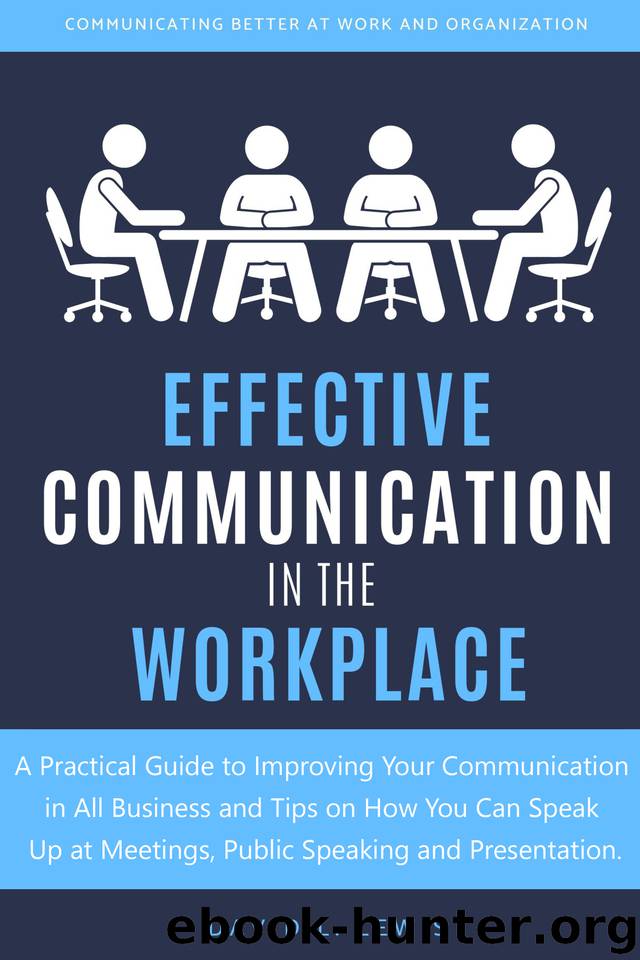Effective Communication in the Workplace: A Practical Guide to Improving Your Communication in All Business and Tips on How You Can Speak Up at Meetings, Public Speaking and Presentation by L. Lewis David

Author:L. Lewis, David [L. Lewis, David]
Language: eng
Format: epub
Published: 2019-09-02T16:00:00+00:00
Chapter 10: Start and Finish on Time
Presenting is a two-way process; a “dialogue” between you and your audience’s intellect and emotions. You have prepared your presentation so that it is relevant, interesting and thought provoking for the particular audience you are speaking to. As you deliver it you have to respond to their reactions, the energy levels in the room, the circumstances and situation. You have to make quick, calm, on-the-spot-judgments and vary your delivery, and to a certain extent your content, accordingly. This is what is called “timing,” and it helps keep a presentation spontaneous, immediate and interesting. It also means you are really talking to your audience, not at them.
It is after lunch, in a hot room and the audience is flagging; you can patently see people struggling to stay awake. Your response must be to up your energy levels: in your facial expression, your gesture, and your movement; perhaps walking to one side of the room, addressing the audience there, and then walking positively back or even round the whole room if you feel confident to do so.
Time restriction is a natural element of most presentations. It is your responsibility to finish your presentation within the set time limit. Consider this as an agreement between you and your audience.
Planning
Prioritizing your information is vital, especially at the early stage of planning for your presentation. During the planning process, set your notes aside and write a simple outline of what you intend to present. The outline should be from a progression of logically structured core points.
After identifying your main points, proceed to support your argument with suitable data. Carefully select each main point’s supporting detail. It’ll be quite easy for the audience to recollect one or two impactful examples. Less enlightening data will not be as effective.
Lastly, plan a powerful introduction (opening) and conclusion (closure) for your presentation. As discussed in earlier chapters, the information you include in these sections must be effective. Don’t leave its essential elements to chance.
Planning How to Use Your Time
After writing the content of your presentation, it is essential to map out how you intend it to be delivered. This includes a clear plan of when the materials will be handed out, the precise time you'll explain specific slides, and the point where questions will be taken. This is to make the components of your presentation look more deliberate, in addition to ensuring that such nonspoken sections of the presentation are allotted time.
During rehearsal, don’t just run through the words. Try as much as possible to present close to what you want to present on the main day. Only a few aspects of the presentation will be played out if you just run through the words in your head. Time the whole thing. If this means that you have to rehearse out loud and pause where you've highlighted a pause or other activities to take place, do it. It leads to an excellent presentation.
Decide your "talk time.” Although you know beforehand how long you are expected to talk for, it is impossible to keep to the exact time.
Download
This site does not store any files on its server. We only index and link to content provided by other sites. Please contact the content providers to delete copyright contents if any and email us, we'll remove relevant links or contents immediately.
The Compound Effect by Darren Hardy(8739)
Tools of Titans by Timothy Ferriss(8159)
Nudge - Improving Decisions about Health, Wealth, and Happiness by Thaler Sunstein(7465)
Win Bigly by Scott Adams(7035)
Deep Work by Cal Newport(6822)
Rich Dad Poor Dad by Robert T. Kiyosaki(6321)
Pioneering Portfolio Management by David F. Swensen(6172)
Principles: Life and Work by Ray Dalio(6134)
The Barefoot Investor by Scott Pape(5651)
Digital Minimalism by Cal Newport;(5590)
Grit by Angela Duckworth(5451)
The Slight Edge by Jeff Olson(5318)
Discipline Equals Freedom by Jocko Willink(5243)
The Motivation Myth by Jeff Haden(5127)
You Are a Badass at Making Money by Jen Sincero(4734)
The Four Tendencies by Gretchen Rubin(4517)
Eat That Frog! by Brian Tracy(4389)
The Confidence Code by Katty Kay(4162)
Bullshit Jobs by David Graeber(3997)
